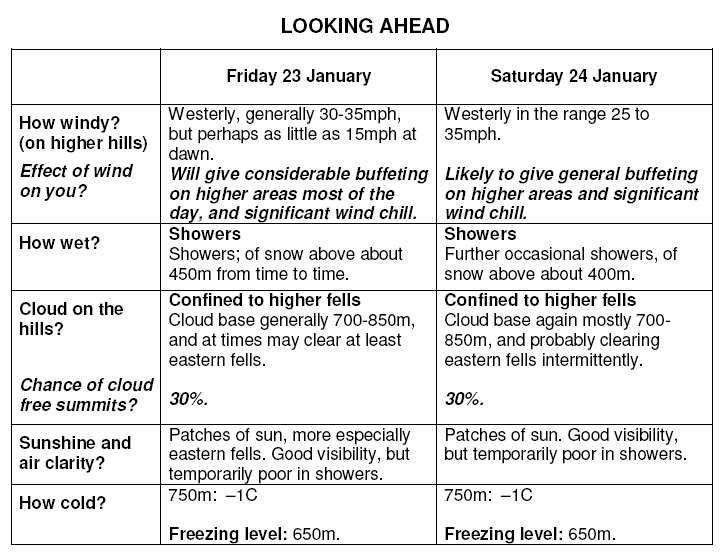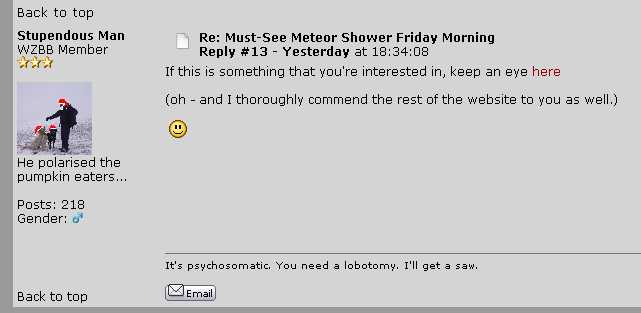A section of The Gospel according to St. MWIS of the Lakes:

The usual rules will be applied with rigour (the first one to fall over buys the beers).
A section of The Gospel according to St. MWIS of the Lakes:

The usual rules will be applied with rigour (the first one to fall over buys the beers).
As usual, the good old British weather kicked up a storm for the WHB*, with winds of 20-40 mph tearing boughs from trees and flattening whatever we were hoping to grow in the garden. Of course, it also banjaxxed our hopes of a pleasant seasonal day out the kids, but eventually we couldn't stand being cooped-up indoors any longer, so we grabbed coats and kites and headed off to Bosworth Park.
We set up Anna's 1.2m foil first, let it go and it was overhead no time, pulling hard but still manageable.
Next we started to set up Ella's 1.6m, but part-way through a good gust caught Anna's kite, it was too much for one of her lines which promptly pinged and snapped. We decided to put Ella's stronger lines on Anna's kite and arranged for them to take turns with it, on the basis that Ella's kite would be too much for Anna to hold down.
All seemed to be going well with them, so I unpacked the Ozone Imp and had a think about which lines to use with it...
On breezy days I usually fly it on a pair of 30m 70kg Climax Protecs, these lines have virtually no stretch and are really thin and slick, meaning that there's a lot of control and it's easy to wrap/unwrap twists made during spins. The longer length also means that it's easy to find more wind at the edge of the flying window. On windier days I tend to stick with the 18m 100kg braided Edelrid SK75 Dyneema lines that came with the kite - they're thicker and heavier, meaning that there's more wind-drag on them, cutting down the responsiveness and feel, but the shorter lines allow a more direct contact with the foil, there being less slack than an equivalent long line.
Decisions, decisions...
In the end, I set up with the Protecs. Chris had the controls while I held up the kite and launched it. It went up like a rocket, but Chris couldn't control it and it was soon back on the ground. Chris didn't want to fly it any more, so I took the leashes while she put the foil into the air. Yet again it went straight up without complaint, so I started to hunt around to find where the good and bad air was. Right at the top of the window I ran into some slack air and the kite-cells emptied, resulting in a fold-up and a relatively gentle fall back to earth. I gave one of the lines a gentle tug to free a minor wrap-around and the thing was back in the air immediately, pulling like a good 'un. Then...
Crack!
The left line snapped a few feet below the kite which started to spin out of control 50ft up. The one remaining line now had to contend with the full force of the wind combined with the force of me recoiling from the breakage...
"Is it still attached?" asked Chris.
I looked up at kite. I looked across at the line.
"Yes."
It was hanging on bravely, but it was all too much... there was a slackening in the line...
"Err... NO!"
And it was off, over the field, no longer fighting the wind but being whisked away by it. It went up and over a huge oak tree, showing no signs of coming down beyond it. I was transfixed, in utter disbelief.
And all of a sudden Chris was off too, charging over the field in hot pursuit! I was doubly-transfixed, and in utterly utter disbelief! I've never seen her move so far so fast - she must have covered 250, perhaps 300 yards in well less that a minute, which is impressive for an asthmatic wearing walking-boots and a full complement of Paramo "waterproofs"!
She caught up with it when it snagged in some bushes at edge of the housing estate, bundled it up and strolled back in triumph, muttering things like "have you any idea how much I paid for this?" and "I can't believe that you just stood there and didn't chase it yourself."
Ella and Chris went for a walk around the park while I packed up and retired to the car, disgraced, to untangle the mess and salvage whatever good line was left. Anna came with me, she'd had enough fun for one day.
Next time I'll use the 100kg lines, or the replacements that I'm considering.
*WHB: the result of a brilliant "triumph of mouth over brain" by a Radio Cumbria presenter back in the 80s. I was checking out the weather forecast on the car radio while site-camping at Castlerigg Hall near Keswick when I heard "... and here is the weather forecast for the wank-holiday beak-end...". I laughed so much that I ached for days. I do hope the lass didn't lose her job because of it, but I never did hear her on the radio ever again.
Just to add insult to injury, the skies were clear and bright for long periods last night, acceptable for observing but, alas, my pass from SWMBO had expired.
Anyway, here's a big thanks to Stupendous Man for spreading the word about my interest in such matters.

Of course, there's no prize for guessing the true identity of Stupendous Man. Let's just say that it's not me.
Well, the forecast was half-correct...
It was cloudy all night and it's still like that now, so the Quadrantid observing session was indeed scuppered as predicted.
Sadly, the predicted snow and low temperatures didn't happen, we got intermittent showers instead, so there'll be no walking in the white stuff this weekend. Looks like we'll have to go to the Snowdome instead.
Preparations have been made and permission to view the shower has been granted by my better half, but it looks like it'll be scuppered by the weather. The forecast for here is for overcast skies and snow, it's 8/8 cloud cover right now so it doesn't bode well for the early morning.
For those lucky enough to get clear skies, the show should be good, with a short peak (<2 hours) of maximum activity around 06:40, when rates should hit over 100/hour.
Where to look? Well, the meteor trails appear to radiate from the "obsolete" constellation of Quadrans Muralis, so look a fair number of degrees away from there. My favoured place to aim the camera at would be the Plough, or whatever you prefer to call it, as it's easily framed and difficult to miss. Others would, no doubt, disagree. Here's a link to a helpful chart and here's a link to a NASA Vodcast. Of course, it'll be a good shower to just watch the good old-fashioned way, without the hassle of demisting/defrosting the camera, keeping the batteries warm and cursing the low-flying planes circling around EMA.
So, what's needed for observing this shower?
Well, you'll need to be properly insulated. Plenty of warm layers, and some spares, it gets damned cold at night this time of the year if you're in this neck of the woods (52 degrees North). Fur-lined boots are brilliant if it's frosty, and if you're mad like me, sticking your booted feet in a cardboard box can keep a breeze off your feet as well as providing insulation from the ground. A comfy chair's great for sitting, but I've managed to get myself frozen to mine a few times so be careful when you stand up after a long frosty rest, you'll feel like an eejut walking around with a deckchair stuck on your back.
I would advise taking hot drinks, or a means to make them (I take the Jetboil and supplies so that I can enjoy the luxury of a fresh cuppa). If you're partial to snacks, be aware that things like chocolate will melt in your pocket, or freeze to the consistency of a dinner-plate if you leave then out in the cold.
As for camera settings, well, aperture is everything, just shoot wide-open, in RAW format if possible. There's no point in going for long exposures if the target is only in field for a second or so. Besides, longer exposures mean longer star-trails, unless you're using a tracking mount. Go for a wider lens rather than a tele, so that you can frame a familiar area of the sky. A tripod is more-or-less mandatory, and a remote release is more useful than using a self-timer. Keep an eye on the effect that the cold is having on your camera, demisting and defrosting tends to be needed more often than you think, and condensation on the inner elements of the optics can be a pain to deal with. One useful tip - manually focus your lens on infinity and paint a couple of alignment marks on it before you go out into the dark. Focusing in the dark can be a nightmare, especially with autofocus lenses that focus beyond infinity.
One last thing: If you're dependent on your car, FFS keep your de-icer with you. It's no fun being frozen out of your car so early in the morning with a long walk home through the snow while carrying your gear. It's even worse when you can see the de-icer through the frozen window, just lying there taking the p155 out of you.
Sounds like fun, eh? Duncan's tried it, have a shufty at this.
------------------------------------------------------------------
Stop Press! I've just realised that I've missed something... a planisphere is another useful bit of kit, they're available cheap from Amazon and the like. Be sure to get one that's suited to your latitude.
One of the finest, and probably the most reliable, of the major annual showers presently observable. This year, the waxing crescent Moon will set by mid-evening across the globe on December 14 (the actual moonset timing is progressively later the further south you are), giving mostly dark skies for all observers, especially those in the northern hemisphere. The Geminid radiant culminates around 2h local time, but well north of the equator it rises around sunset, and is at a usable elevation from the local evening hours onwards, while in the southern hemisphere, the radiant appears only around local midnight or so. Even from more southerly sites, this is a splendid stream of often bright, medium-speed meteors, a rewarding sight for all watchers, whatever method they employ.Here's some good advice from NASA for those hardy souls who intend to venture forth to see the lightshow:
Notifications